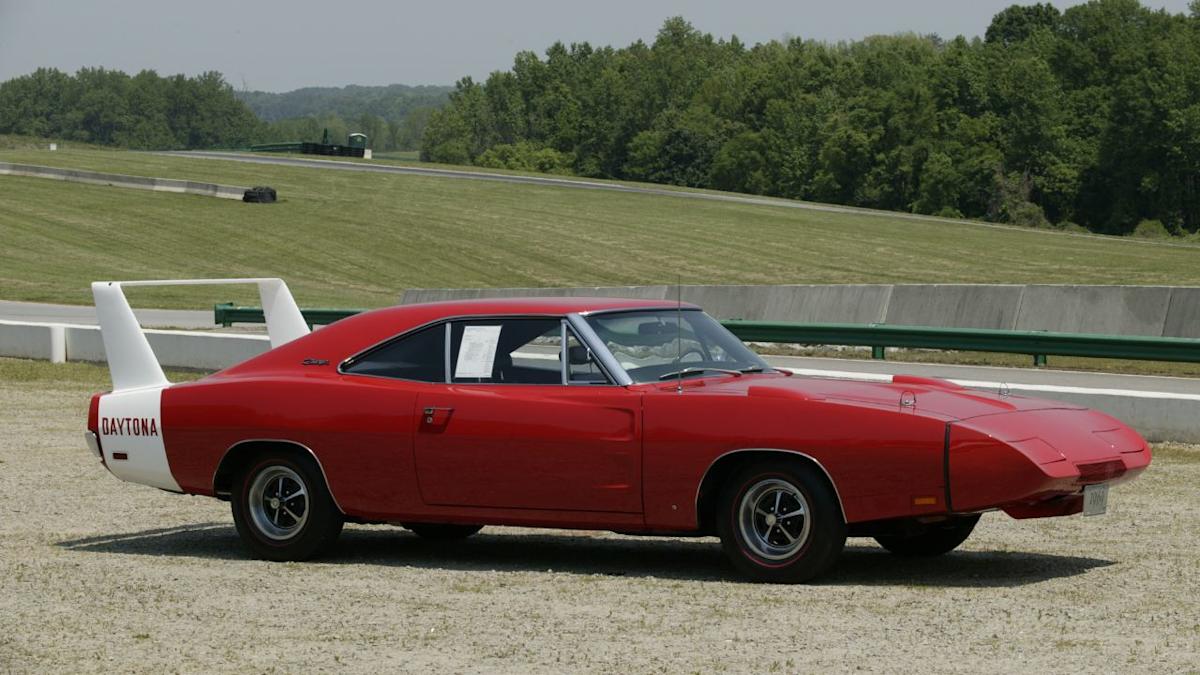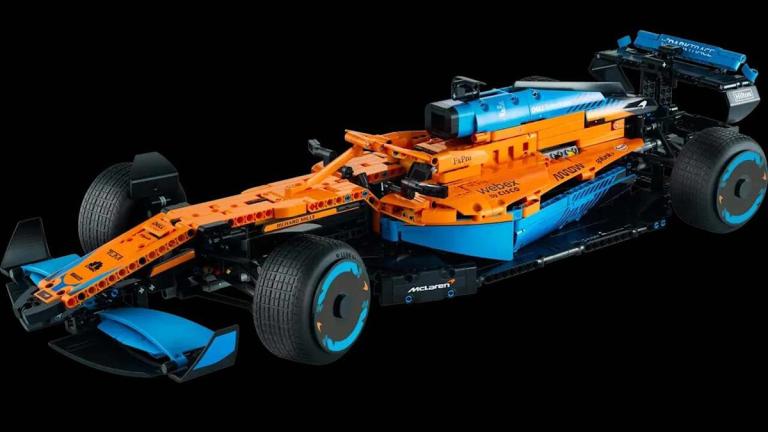
Back when NASCAR cars actually resembled something you could buy at a dealership (imagine that), manufacturers had a brilliant idea: “What if we made our race cars so ridiculous that people would pay us to drive them to work?” This was the era of homologation specials, where companies were required to build at least 500 street versions of their race cars to comply with NASCAR’s “stock car” rules. The result? Some of the most gloriously impractical daily drivers ever unleashed on unsuspecting suburbia.
From towering wings that doubled as conversation starters to nose cones that could part traffic like Moses, these machines brought the drama of Daytona directly to your driveway. Richard Petty didn’t just win races in these things; he validated every guy’s fantasy of owning something that looked like it escaped from a NASA wind tunnel.
Plymouth Superbird
Image Credit: BUTTON74 – Own work, CC BY-SA 4.0/Wiki Commons.
Production Numbers: 1,935 units (NASCAR required 1,500 minimum)
Engine Options: 440 Six Pack (390 hp) or 426 Hemi (425 hp)
Top Speed: 200+ mph (with the right gearing and infinite bravery)
The Plymouth Superbird resembled someone attaching a park bench to the back of a Dart and calling it aerodynamics. That towering rear wing wasn’t just for show. It generated real downforce and made the car stable at speeds that would make your insurance agent faint.
The 18-inch nose extension housed the headlights and helped the car slip through the air like a very loud, very angry arrow. Chrysler’s engineers discovered that making a car look completely ridiculous could actually make it faster, a lesson modern supercar designers still follow today.
Richard Petty won 18 races in the NASCAR version, proving that sometimes the best way to dominate your competition is to show up looking like you’re from the future. The street version came with luxurious touches like A/C and AM/FM radio, because nothing says “practical family transportation” like a car that needs a spotter to back out of parking spaces.
Dodge Charger Daytona

Image Credit: Stellantis.
Production Numbers: 503 units (the bare minimum to satisfy NASCAR)
Engine Options: 440 Magnum (375 hp) or 426 Hemi (425 hp)
Top Speed: 200+ mph (first NASCAR car to crack 200 mph)
Oh look, another massively winged track monster that pedestrians can reach over 200 miles per hour in! This thing looked like it was designed by aerospace engineers having a fever dream about winning at Talladega. The pointed nose cone and massive wing made it instantly recognizable and completely impractical for anything involving drive-thrus or low-hanging branches.
Dodge built exactly 503 of these street monsters: the absolute minimum NASCAR required for homologation that year. They knew they were creating something special and weird, so why make more than legally necessary? Each one came with a certificate of authenticity, probably because nobody would believe you owned one otherwise.
The Daytona became the first NASCAR car to exceed 200 mph, piloted by Buddy Baker at Talladega. On the street, it offered a unique driving experience, piloting something that looked like it belonged on a rocket launch pad rather than in suburban traffic.
Ford Torino Talladega

Image Credit: Michel Curi-Flickr-CC BY 2.0/Wiki Commons.
Production Numbers: 754 units
Engine: 428 Cobra Jet (335 hp, but everyone knew it made more)
NASCAR Wins: 34 victories in 1969-1970
Ford took a different approach with the Talladega — instead of bolting wings and nose cones everywhere, they simply stretched the front end by five inches and called it subtle. This was Ford’s version of stealth technology: make it faster without scaring the neighbors too much.
The extended nose housed a unique grille and headlight setup that improved airflow and reduced lift at high speeds. Ford’s engineers proved you could dominate NASCAR without looking like you raided the Jetsons’ garage.
Cale Yarborough and David Pearson made Talladega famous on Sunday, while street buyers got a car that could embarrass Corvettes without attracting quite as much attention from law enforcement. The perfect weapon for gentleman racers who preferred winning to posing.
Chevrolet Monte Carlo SS Aerocoupe

Image Credit: MercurySable99 – Own work, CC BY-SA 4.0/Wiki Commons.
Production Numbers: 6,052 units (making it relatively “common” on this list)
Engine: 305 V8 (180 hp — hey, it was the ’80s)
Special Feature: That gloriously sloped rear window
By the mid-1980s, NASCAR had become obsessed with aerodynamics, and Chevy’s answer was to give the Monte Carlo SS a rear window that resembled a melting one. The Aerocoupe’s fastback design improved high-speed stability, giving the car a look that seemed perpetually leaned into a turn.
Sure, 180 hp doesn’t sound like much today, but this was during the depths of the malaise era when that was actually competitive. The real magic happened at speed, where the Aerocoupe’s slippery shape gave it an advantage over the competition’s brick-like aerodynamics.
Dale Earnhardt Sr. made the Monte Carlo famous in NASCAR, though his intimidator persona might have been enhanced by driving something that looked perpetually angry. The street version offered a taste of that attitude without the need for a roll cage and racing fuel.
Buick Regal Grand National

Image Credit: Gestalt Imagery / Shutterstock.
Production Numbers: 20,193 Grand Nationals total; special NASCAR editions are much rarer
Engine: 3.8L turbocharged V6 (245 hp, 355 lb-ft)
Quarter Mile: Mid-13s (embarrassing Corvettes and Ferrari 308s)
The Grand National proved that sometimes the most menacing thing in your rearview mirror comes from the luxury division. Buick’s turbocharged V6 delivered torque like a freight train and embarrassed more exotic machinery with ruthless efficiency.
The all-black paint scheme earned it the nickname “Darth Vader’s car,” although we prefer to think of it as what happened when Buick’s engineering team was given permission to be completely unreasonable. The turbocharged V6 produced more real-world torque than most V8s while consuming premium unleaded fuel with slightly less thirst.
NASCAR versions received aerodynamic tweaks, including a more aggressive front air dam and a unique rear spoiler. The streetcar’s party trick was making Corvette owners question their life choices at stoplights, all while offering power windows and air conditioning.
Mercury Cyclone Spoiler II

Image Credit: Gestalt Imagery / Shutterstock.
Production Numbers: 1,631 units
Engine Options: 428 Cobra Jet or 429 Boss
Claim to Fame: One of Dan Gurney’s NASCAR weapons of choice
Mercury’s Cyclone Spoiler II was the result of Ford’s luxury division joining the aerodynamic arms race. The extended nose and unique rear spoiler weren’t just styling exercises: they were wind tunnel-tested solutions to the problem of going really, really fast in circles.
Dan Gurney piloted the NASCAR version to several victories, proving that sometimes the best way to beat Dodge and Plymouth’s flying machines was with your own slice of aerospace engineering. The street version offered a similar look with slightly more consideration for factors such as parking and insurance rates.
The Spoiler II represented Mercury’s brief moment as a performance brand, before the division settled into its role as “Ford, but fancier.” Today, they’re among the rarest muscle cars, probably because most people don’t remember Mercury made anything this exciting.
Pontiac Grand Prix 2+2 Aero Coupe

Image Credit: Pokemonprime – Own work, CC BY 4.0/Wiki Commons.
Production Numbers: 1,225 units
Engine: 305 V8 (165 hp in base form)
Special Feature: Unique fastback roofline that actually worked
Pontiac’s 2+2 Aero Coupe was the division’s last gasp at NASCAR relevance before everything shifted to front-wheel drive and became more reasonable. The dramatically sloped rear window and extended nose created a shape that looked fast even when parked, which was probably good because 165 horsepower wasn’t setting any land speed records.
The Aero Coupe’s real contribution was proving that aerodynamics could still matter in an era when most performance cars looked like brick-shaped reminders of the good old days. NASCAR teams discovered genuine speed advantages in the wind tunnel-tested shape, even though street buyers were primarily paying for the appearance.
Rusty Wallace made the Grand Prix competitive in NASCAR, although by then the connection between race cars and street cars was becoming increasingly theoretical. The 2+2 represented the end of an era when you could actually buy something resembling what won races on Sunday.
Closing Laps on a Racing Legacy

Image Credit: Gestalt Imagery / Shutterstock.
These cars remind us of a time when “based on our NASCAR racer” wasn’t marketing speak, it was the literal truth. Manufacturers built wild, impractical machines because the rules demanded it, and somehow convinced normal people to buy them for grocery runs and school pickups.
Today’s supercars might be faster, safer, and more refined, but they’ll never match the pure audacity of selling a 200-mph race car with a warranty and cup holders. These homologation specials proved that sometimes the best way to build something memorable is to ignore practicality entirely and embrace the absurd.
They’re rolling reminders that car companies once had the confidence to ask customers: “Would you like your daily driver to double as a barely-legal race car?” And amazingly, enough people said yes to keep the dream alive.
The next time you see one of these winged warriors at a car show, remember: you’re looking at what happens when engineering brilliance meets regulatory loopholes, and somehow both sides win. They’re not just cars; they’re proof that sometimes the most ridiculous ideas make the most sense.




